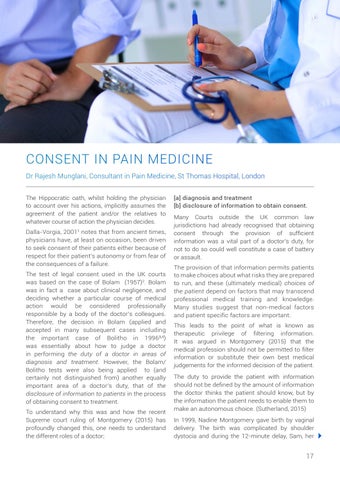MEDICO LEGAL M A G A Z I N E
CONSENT IN PAIN MEDICINE Dr Rajesh Munglani, Consultant in Pain Medicine, St Thomas Hospital, London The Hippocratic oath, whilst holding the physician to account over his actions, implicitly assumes the agreement of the patient and/or the relatives to whatever course of action the physician decides. Dalla-Vorgia, 20011 notes that from ancient times, physicians have, at least on occasion, been driven to seek consent of their patients either because of respect for their patient’s autonomy or from fear of the consequences of a failure. The test of legal consent used in the UK courts was based on the case of Bolam (1957)2. Bolam was in fact a case about clinical negligence, and deciding whether a particular course of medical action would be considered professionally responsible by a body of the doctor’s colleagues. Therefore, the decision in Bolam (applied and accepted in many subsequent cases including the important case of Bolitho in 19963,4) was essentially about how to judge a doctor in performing the duty of a doctor in areas of diagnosis and treatment. However, the Bolam/ Bolitho tests were also being applied to (and certainly not distinguished from) another equally important area of a doctor’s duty, that of the disclosure of information to patients in the process of obtaining consent to treatment. To understand why this was and how the recent Supreme court ruling of Montgomery (2015) has profoundly changed this, one needs to understand the different roles of a doctor;
[a] diagnosis and treatment [b] disclosure of information to obtain consent. Many Courts outside the UK common law jurisdictions had already recognised that obtaining consent through the provision of sufficient information was a vital part of a doctor’s duty, for not to do so could well constitute a case of battery or assault. The provision of that information permits patients to make choices about what risks they are prepared to run, and these (ultimately medical) choices of the patient depend on factors that may transcend professional medical training and knowledge. Many studies suggest that non-medical factors and patient specific factors are important. This leads to the point of what is known as therapeutic privilege of filtering information. It was argued in Montgomery (2015) that the medical profession should not be permitted to filter information or substitute their own best medical judgements for the informed decision of the patient. The duty to provide the patient with information should not be defined by the amount of information the doctor thinks the patient should know, but by the information the patient needs to enable them to make an autonomous choice. (Sutherland, 2015) In 1999, Nadine Montgomery gave birth by vaginal delivery. The birth was complicated by shoulder dystocia and during the 12-minute delay, Sam, her
17
